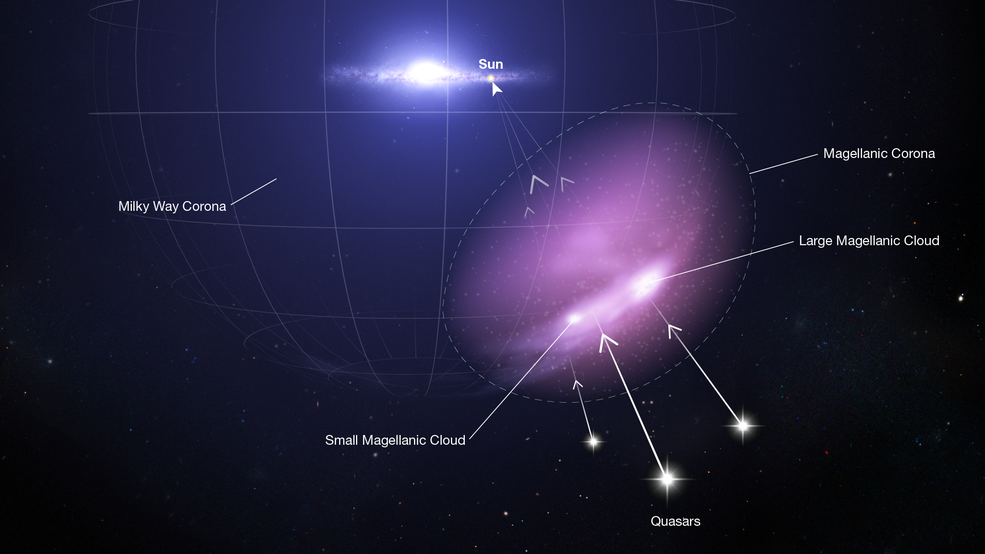Hubble Detects a Protective Shield Defending a Pair of Dwarf Galaxies
While two of the Milky Way’s largest satellite galaxies, the Large and Small Magellanic Clouds, have spent billions of years orbiting one another as they are pulled in toward our home galaxy, a study, just published in Nature, has puzzled astronomers as to why these dwarf galaxies remain intact, with ongoing vigorous star formation.
According to Dhanesh Krishnarao, assistant professor at Colorado College, a lot of people have been struggling to explain how these streams of material could be there. “If this gas was removed from these galaxies, how are they still forming stars?” Krishnarao said.
A group of researchers led by Krishnarao has finally discovered the answer using data from NASA’s Hubble Space Telescope and a retired satellite called the Far Ultraviolet Spectroscopic Explorer (FUSE). The Magellanic system is surrounded by a corona, a shield of hot, supercharged gas. This envelops the two galaxies and prevents the Milky Way from absorbing their gas supplies, allowing them to continue forming new stars.
The recent discovery deals with a novel aspect of galaxy evolution. According to Andrew Fox, co-investigator of the Space Telescope Science Institute in Baltimore, Maryland, galaxies encase themselves in gaseous cocoons, which serve as defensive shields against other galaxies.

Researchers have used spectroscopic observations of ultraviolet light from quasars to detect and map out the Magellanic Corona, a diffuse halo of hot, supercharged gas surrounding the Small and Large Magellanic Clouds. Shown here in purple, the corona stretches more than 100,000 light-years from the main mass of stars, gas, and dust that make up the Magellanic Clouds, intermingling with the hotter and more extensive corona that surrounds the Milky Way. The Magellanic Clouds, dwarf galaxies roughly 160,000 light-years from Earth, are the largest of the Milky Way’s satellites and are thought to be on their first in-falling passage around the Milky Way. This journey has begun to unravel what were once barred spirals with multiple arms into more irregular-shaped galaxies with long tails of debris. The corona is thought to act as a buffer protecting the dwarf galaxies’ vital star-forming gas from the gravitational pull of the much larger Milky Way. The detection of the Magellanic Corona was made by analyzing patterns in ultraviolet light from 28 distant background quasars. As the quasar light passes through the corona, certain wavelengths (colors) of ultraviolet light are absorbed. The quasar spectra become imprinted with the distinct signatures of carbon, oxygen, and silicon ions that make up the corona gas. Because each quasar probes a different part of the corona, the research team was also able to show that the amount of gas decreases with distance from the center of the Large Magellanic Cloud. This study used archival observations of quasars from Hubble’s Cosmic Origins Spectrograph (COS) and the Far Ultraviolet Spectroscopic Explorer (FUSE). Quasars have also been used to probe the Magellanic Stream, outflows from the Milky Way , and the halo surrounding the Andromeda Galaxy.
Illustration Credits: STScI, Leah Hustak/NASA
Astronomers predicted the corona’s existence several years ago. For the first time, according to Elena D’Onghia, a co-investigator at the University of Wisconsin–Madison, the astronomers discovered that if they included a corona in the simulations of the Magellanic Clouds falling onto the Milky Way, they could explain the mass of extracted gas for the first time. “We knew that the Large Magellanic Cloud should be massive enough to have a corona,” said D’Onghia.
However, while spanning a major part of the southern sky and extending more than 100,000 light-years from the Magellanic clouds, the corona is essentially invisible. It required searching through 30 years of old data for appropriate metrics in order to map it out.
According to astronomers, a galaxy’s corona is a piece of the original gas cloud that collapsed billions of years ago to create the galaxy. Despite the fact that coronas have been spotted around more distant dwarf galaxies, astronomers have never been able to examine one in such great detail.
The astronomers say there are lots of predictions from computer simulations about what they should look like and how they should interact over billions of years, but observationally they can’t really test most of them because dwarf galaxies are typically just too hard to detect. Because, as Krishnarao said, they are right on our doorstep, the Magellanic Clouds provide an ideal opportunity to study how dwarf galaxies interact and evolve.
The team examined the Hubble and FUSE archives for ultraviolet observations of quasars that were billions of light-years away from the Magellanic Corona in an effort to find direct evidence of it. The extraordinarily bright centers of galaxies that contain sizable active black holes are known as quasars. Though the corona would be too faint to be seen by itself, the researchers reasoned that it should be visible as a kind of fog that obscured and absorbed different patterns of strong light from quasars in the background. The Andromeda galaxy’s corona has been studied in the past using quasar observations from the Hubble.
The team was able to locate and describe the material surrounding the Large Magellanic Cloud and establish that the corona exists by examining patterns in ultraviolet light from 28 quasars. As expected, the unique signatures of silicon, oxygen, and carbon that make up the halo of hot plasma that surrounds the galaxy are etched on the quasar spectra.
The ability to detect the corona requires extremely detailed ultraviolet spectra. “The resolution of Hubble and FUSE was crucial for this study,” explained Krishnarao. “The corona gas is so diffuse, it’s barely even there.” Moreover, it is mixed with other gases, including the streams pulled from the Magellanic Clouds and material originating in the Milky Way.
The team, by mapping the results, also discovered that the amount of gas decreases with distance from the center of the Large Magellanic Cloud. “It’s a perfect telltale signature that this corona is really there,” said Krishnarao. “It really is cocooning the galaxy and protecting it.”
Krishnarao continues by stating that anything trying to enter the galaxy must first pass through this material in order for it to reduce its impact.
In addition, the corona is the first material that may be extracted, as Krishnarao added. By giving up a tiny fraction of the corona, you are able to preserve the galaxy’s inside the gas, which is capable of forming new stars.
The Hubble Space Telescope, operated by NASA’s Goddard Space Flight Center in Greenbelt, Maryland, is a NASA and ESA collaborative international project (European Space Agency).


